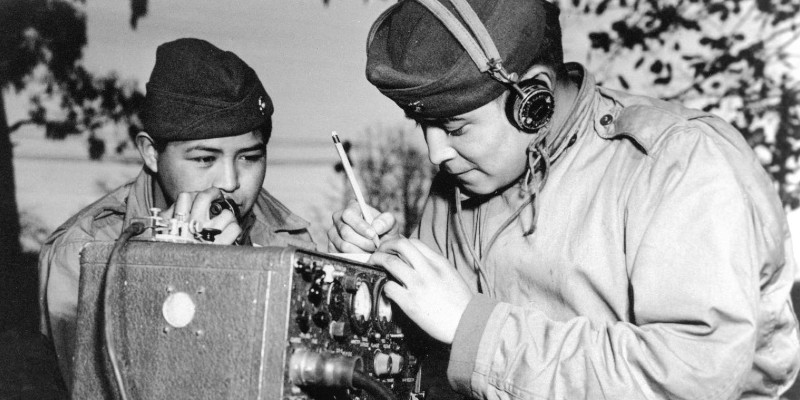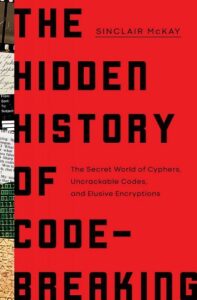Sometimes secret codes can be the poignant echoes of languages that have been suppressed by conquering powers. There are words and phrases and cadences that have been smothered by oppressors and, as such, can be used by their original speakers in the spirit of defiance. This was the case for the languages spoken by the many tribes of the Native Americans in the early years of the twentieth century, whose lives and cultures had been decimated by the swarming colonialists taking over the whole of North America. The new rulers of the west decreed that the children of Native Americans should be turned away from the old tongues. They were enrolled in boarding schools far from their own homes to be educated out of old family ways. Yet somehow the languages survived. And out of this cruelly implacable conquest came a rather beautiful cryptography development in the Second World War.
Languages such as Navajo and Comanche were suddenly called into fresh life during the war years when they were needed to communicate secrets. These were tongues that the Japanese would not have the first idea about. The languages were used in substitution ciphers, one word standing for a particular letter. And in faster moving theatres of war, the languages would be spoken as they were when they were formed – a swift and brilliant means of conveying messages and intelligence. Sometimes the poetry of these crushed languages even found fresh flowering. The men who became the ‘code talkers’ found themselves at the heart of the conflict and their contribution was invaluable.
The idea had been around since the Great War. And indeed, in the inter-war years, as the Nazis ascended to power in Germany, they too took an interest in the possibility that the languages of the Native Americans offered (there is a suggestion that Goebbels considered these peoples ‘Aryan’). A few German linguists were assigned the task of immersing themselves in Comanche, both to get a feel for it and also to see what code possibilities presented themselves. Some, posing as graduate students, came specifically to the States to try to discreetly find ways of studying it. Yet with bitter irony, it turned out that there was little written material for them to draw from. The nineteenth- and twentieth-century erasure of these native languages was so thorough that there was no literature to be found on them. The Comanche people had, among themselves, managed to keep the traditions and the language alive, but there was little for the outside world to see.
A further bitter irony was that the American government had good reason to be grateful that these and other native tongues had not been so thoroughly exterminated as intended. And fortunately, some of the young Native Americans who had been through those obligatory government boarding schools to turn them away from their old traditions were perfectly enthusiastic about throwing their skills into the conflict that was coming. Some of the traditions that the US authorities had sought to stamp out were warrior rites of passage. The young Comanches and other Native Americans had never forgotten them and here was an opportunity to offer their courage on their own terms, with skills that only they possessed.
When America was finally pulled into the war in December 1941, following the Japanese bombing of Pearl Harbor, the code talkers were swiftly assembled. Indeed, some had been brought together a year earlier. As an example, a company of two dozen Choctaw speakers from Oklahoma had been mustered and they had been put through the rigorous training of signals intelligence. Together they worked to contrive a brand-new code that would employ the Choctaw language, while at the same time keeping the meanings opaque. Because of new modern technology, there were some English terms that had no equivalent in Choctaw – and the result was an outbreak of delightful (and cryptic) similes. For instance, they would make references to ‘sewing machine guns’, and mighty ‘turtles’, all under the direction of ‘Crazy White Man’. Even if enemy interceptors picked up these terms unencoded and managed to translate them from the Choctaw, what could they have made of them in any event? ‘Turtles’ referred to tanks and ‘sewing machine guns’ were in fact machine guns. And Hitler would have been displeased to hear that he was the ‘Crazy White Man’.
The brilliance of the code talkers was to reach its height in the summer of 1944, and in the bitter final battles beyond as the Nazis were finally vanquished. Teams of Choctaw speakers, Comanche speakers and Hopi speakers were among the thousands who, with grace and courage, crossed from England to France on 6 June 1944 – D-Day. At the start of the desperate battle for the soul of Europe, the code talkers proved brilliantly agile and dexterous in getting vital intelligence over to units moving across all sorts of terrain. With radios, headphones and field transmitters, these signals operatives were on those deadly beaches as the landing parties were attacked, moving through countryside infested with a still venomous enemy, and as they spread out through France, Luxembourg and Belgium, their exquisite languages formed an indispensable web of unbreakable communication. The hazards all these men faced were akin to those that the agents of the Special Operations Executive were also challenged with. There were gun battles, mortar attacks and the constant threat of injure, capture or death. Even so, through all of this, the code talkers provided incredibly fast, on-the-ground intelligence. The commanding officers in several platoons were profoundly impressed with their lateral-thinking recruits.
As with all matters cryptanalytical, the tragedy of the story of the code talkers is that the brilliant work they did, and the courageous feats they pulled off, had to remain a secret for many years afterwards. Who knew if such secret codes might be needed again? Therefore many of the code talkers had to wait a great many years before they got the full public recognition and the praise that they deserved. There were post-war instances where Comanche men, now demobilised and back in the US, took part in traditional celebration dances where the cloud of war could be ceremonially dispelled from their heads. Happily, their story could finally be told and even now there are branches of the US military that periodically honour this brave fleet of code-carriers. After all the bitter years of violence and suppression in the nineteenth and twentieth centuries, as Native Americans were harried and dispossessed, this at least is a small recognition of the richness of the culture that the United States had once sought to wipe from the land.
___________________________________


















